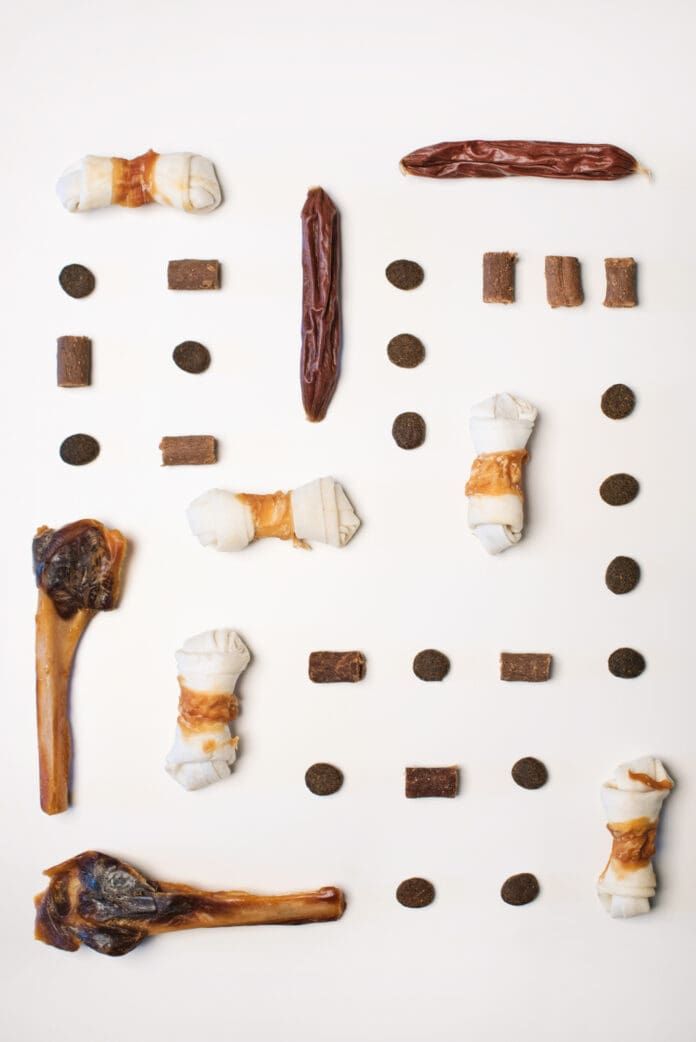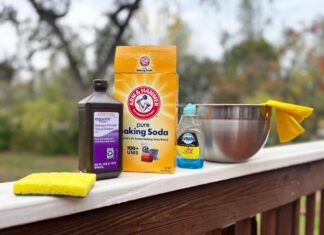[Updated June 17, 2016]
Walk down the right aisle in any pet supply store and you can’t miss them: row upon row, bin upon bin of preserved and processed animal parts, all intended for your dog’s chewing pleasure.
First, there are the rawhide products – perhaps the least visually objectionable stuff on display. Most pet stores carry many varieties of rawhide chews, including flat discs, round rolls, twisted and braided chews, and fanciful items such as rawhide footballs and food bowls.

Nearby you’ll likely find the knackery wares: cattle hooves, bones, tendons, and penises, and pig ears and snouts – items that can make even the most seasoned carnivore cringe, though they may delight your dog.
Are these animal-based chews, even the ones labeled “all-natural,” truly safe for your canine companion?
The short answer: It depends.
What’s an “All-Natural,” Dog Chew Anyway?
The phrase “all-natural” shouldn’t be construed as either healthy or true. The term actually has no legal or regulatory definition, according to the Food and Drug Administration. Labeling a finished product as “all-natural” could simply mean the final processor hasn’t used any preservatives. But it may have been bathed in chemicals when processed, dunked in a liquid smoke substance for flavoring, or worse; there’s just no way to know. Despite the fact that dogs do eat these things, they are not considered “food,” and there are no federal agencies that oversee or regulate the market other than to provide permits required for production.
Some vendors tout their wares as “all natural” based simply on the marketing materials or ingredient lists sent to them by suppliers, without researching what’s behind the final product. The Leash Connection, a retailer in Clayton, Alabama, sells its wares online and touts its “natural dog bones, natural dog treats, and natural dog chews.” When we asked Carmen O’Conner, a spokesperson for the company, what makes the products natural, she said, “I just go by what they (the suppliers) list the ingredients as.”
The company isn’t breaking any rules or laws; it’s perfectly legal for a manufacturer to list the ingredients of a rawhide chew as “100% cowhide,” even if the hide was washed in formaldehyde and whitened with titanium dioxide.
Think about it: All products that are of animal origin need to be treated in some way to prevent spoiling. The trick is finding products that contain a minimum of the preservative chemicals, yet are still free of harmful bacteria. And because these products are not considered “food,” they fall into a regulatory grey zone, with little (if any) oversight from either the Department of Agriculture or the FDA.
The Rap on Rawhide
Among the most popular of the animal-based chews is the basic rawhide. Chewing rawhides satisfies a dog’s need to exercise his jaws, relieves boredom, and aids dental health, since chewing rawhides can help remove plaque and tartar from a dog’s teeth.
There are three main raps on rawhides: problems associated with the physical act of chewing and swallowing the chews (such as broken teeth, choking, gastrointestinal obstructions, etc.); bacterial contamination; and concerns about the presence of manufacturing chemicals in the animal-based products. This article focuses mainly on the latter concerns; see sidebar, below, for more information about the former problems.
Many people don’t think about the origin of the products they buy for their dog’s enjoyment, whether out of naiveté or because they hate to consider their role in the factory farming and slaughter industries (that’s a topic for another day). But given the popularity of animal-based treats and chews, it’s useful to consider the process of their manufacture.
The process of making rawhide chews starts at the tannery, where hides are first de-haired through a physical and a chemical process. They are treated with another chemical to “puff” the hide, making it easier to split into two layers; the upper layer is earmarked for leather goods – shoes, purses, and so on. The lower level is used to make, among other things, rawhide and gelatin.
The split hides, known as “splits,” are then transported to the processor. If the plants are far apart, the hides are frozen or treated with a lime solution.
At the processor, the split is washed, treated with an antibacterial and/or bleaching agent, then cut. It’s formed into shapes, including the traditional rawhide bone and rolled retriever sticks, then dried. After drying, the products are packaged and sent off to distributors.
It sounds like a straightforward process, but there are vast differences between the quality of the end products, depending on the location of the hides’ origin, the processor location, and the distance and travel time between the two. Hides from some tanneries in the Far East and South America are de-haired using arsenic; others may be treated with formaldehyde. Excessive lime may be used to preserve the hides before processing.
While extensive washing in water can remove traces of any contaminants, the process is time-consuming and expensive, and some factories skimp on this step.
“Foreign manufacturers often heavily lime the hides upon receipt to store them longer before processing,” explains Marco Corsi, owner of Pet Factory, one of two companies who process rawhide products in the U.S. “This is not a real problem if one washes the hides enough to fully get the lime out. Measuring the pH will tell you when the rinses are enough, but time is money, and you can process more loads if you shortcut the rinses.”
If the washing process is too short, Corsi explains, the rawhide dries to a cement-hard finish, partly because the lime cuts the fat content in the hides. This makes for a less-palatable, tough chew. “When the final product is rock-hard, it makes the shards of rawhide harder for the dog’s tummy to handle,” says Corsi. “A well-manufactured natural rawhide will actually have some ‘give’ when twisted, and look like a manila folder, with a golden hue.”
Hydrogen peroxide is used to whiten rawhide and to eliminate bacteria. But Corsi warns consumers to avoid products that look as if they are painted white; they probably were painted, with titanium oxide. The coating gets pasty when wet and is unpalatable for most dogs.
If the rawhides are not dried correctly or long enough – a more common problem with rolled or shapes rawhides – the outer layer may dry while the inner layer remains moist. This can create a breeding ground for bacteria. And over time, the rawhide chew slowly putrefies from the inside out – not a healthy treat for your dog.
Rawhide Chews Selection Tips
Select chews that are unlikely to be chewed into separate pieces, for example, the “knotted” chews whose “knots” are separate pieces.
Look for rawhides that are as thick as possible. Your dog will quickly consume products made from thin hides, rather than spend hours cleaning his teeth and toughening his gums on a thick hide.
Do not buy “munchie” or “crunchy” products, made of small chips of rawhide glooped together with binding agents. Again, these products can be consumed too quickly, defeating the purpose giving the dog something to chew.
“Pressed” rawhide chews are especially hard – hard on teeth, but harder for aggressive chewers to consume quickly. Use your discretion.
Do not buy products that are obviously artificially colored. Do not buy unlabeled products of uncertain origin.
Even “Natural” Chews Can Cause Problems
Vets, breeders, and owners all have horror stories they can tell about a dog who died or had a close call from an intestinal blockage caused by swallowing a chunk of rawhide. According to many vets, the more common dangers include pieces stuck in the mouth or the esophagus, upper airway obstructions, broken teeth, and gastrointestinal distress.
Dale Olm, DVM, a co-owner of Southampton Pet Hospital in Benicia, California, says he’s treated several dogs with teeth damaged from chewing rawhides. “We see quite a few slab fractures of the molar teeth from rawhides,” he says. “(Rawhides) do help with dental tartar, but you have to weigh the risk of breaking the teeth with that benefit. Shards of rawhide jammed up under gums, pieces adhered to the roof of the mouth, and bits stuck painfully between teeth are also a worry.
Upper airway obstructions caused by a piece of rawhide wedged across the throat are another danger. I’ve seen the greatest complications in either the esophagus or the throat,” says Michael Schaer, DVM, a professor of small animal medicine at the University of Florida’s College of Veterinary Medicine. If the dog takes in a big, wedge shaped piece of rawhide, that’s where he gets into trouble.
Gastrointestinal distress is a common malady. John Flanagan, DVM, at Studio City Animal Hospital in Los Angeles, estimates that 10 to 15 percent of his canine clients who chew rawhide experience tummy troubles. “Most of the problems aren’t emergencies, but they’re not fun,” he says. “Most commonly, we see bloody diarrhea, or dogs who throw up and don’t want to eat.”
Despite these caveats, all the veterinarians we interviewed agreed that rawhides could be safely given to dogs as long as owners maintain appropriate supervision. Chewers and gnawers do well with rawhides; gulpers and dogs who destroy and down any object in sight don’t. And nothing beats supervision.
“What I always tell people is, if a dog chews it nicely – chewing, shredding, maybe swallowing little bits – they shouldn’t have any problems,” says Sandy Young, DVM, of the Brewerton Veterinary Clinic in Brewerton, New York.
Concerns About Salmonella
Salmonella is a bacteria found in many dairy, poultry, and meat products. Once ingested, it passes into the intestine and can extend to the liver or spleen. Infection by salmonella bacteria can pose a real threat to humans. In a healthy adult, an infection is characterized by diarrhea, abdominal cramps, vomiting, and nausea, which can last up to a week. The elderly, infants, and people with impaired immune systems are at greater risk for contracting a severe infection, which can result in death.
In 1999, Farm Meats Canada was the subject of a Canadian government warning and recall due to the discovery that some shipments of its pig ears were contaminated with salmonella. Some human infections, possibly caused by handling these treats, were reported. In response, the FDA issued an advisory warning U.S. consumers to exercise extreme caution when handling beef- or pork-based dog chews or to avoid them altogether.
In addition, in 2000 the FDA issued an import alert that instructed U.S. authorities to detain without physical inspection dog chews manufactured by 20 companies in 11 countries – including Canada, Brazil, China, Venezuela, Thailand, New Zealand, and Germany – due to suspicions of salmonella contamination in those products.
After its troubles four years ago, Farm Meats Canada made improvements in the handling and processing of its pig ears and other products and also implemented testing procedures to ensure each batch is salmonella-free. The pig ears are not as yet irradiated, although Darby Brewer, the company’s general manager, says when the company begins building a market in the U.S. its policy will be to irradiate any exported product.
No official incidents of salmonella infection in humans related to dog treats have been reported in the U.S. However, despite the best safety precautions at any plant, the possibility of salmonella contamination remains with any meat-based chew.
“Let me tell you, salmonella is tough,” says Petrapport’s Steven Mendal. “You can be as clean and perfectionist as you want, but you can never say 100 percent that you cannot have some salmonella contamination at some point.”
While the FDA was most concerned about the transmission of salmonella to humans, dogs can also get infected. While a healthy adult dog may deal with the bacteria without much trouble, nursing dogs, puppies, and ill animals can be in for trouble.
“It can be a big problem, especially in a critically ill animal, where they become septic,” says Michael Schaer, DVM, of the University of Florida’s College of Veterinary Medicine. “Even a healthy dog can get symptoms including vomiting and diarrhea. And there’s the potential of crossspecies contamination, from dog to human.”
To help avoid these risks, wash your hands after handling meat-based chews, just as you would after handling raw meat. In addition, says Brewer, it’s crucial to supervise children when they’re around the dog’s goodies.
“It’s especially important with little kids, because you know they like to hold whatever the dog is holding, play with the dog’s toys, maybe even put the toy or the chew in their mouths,” he says.
Wash and Rinse
Because of all these possibilities, it’s very hard to say with certainty that a particular rawhide treat is completely safe. Even trace remnants of chemicals can be dangerous.
Frank Burkholder, owner of the Ecology Rawhide Company in Miami, agrees with Corsi that extensive washing is key to producing a top-quality chew. Ecology Rawhide produces the Natural Rawhide brand of chews and operates its own factory in Paraguay. “We go to great lengths to wash the hides,” he says. Washing each batch takes 8 to 10 hours. Ecology Rawhide used hydrogen peroxide to bleach and sterilize the hides. Drying time ranges from a minimum of 48 hours up to 120 hours, at 60 degrees Celsius (about 140 degrees Fahrenheit).
Steven Mendal, COO of Petrapport, which produces the Beefeaters line of dog chews, says his company is also a stickler for quality. Petrapport imports rawhide products from manufacturers in a number of countries, but Mendal says he insists on extensive washing and gentle, safe disinfectant and bleaching agents.
Where the Cows Come Home
Knowledgeable sources generally believe that hides from U.S. cattle are less likely to be adulterated with hormones, antibiotics, and pesticides than those that come from cattle raised in other countries; U.S. cattle farmers are regulated and inspected far more stringently than in other countries. But in a few countries with extensive grazing land and huge cattle herds, such as Brazil and Argentina, the cattle are free-range and grass-fed, and some believe that these cattle contain fewer chemicals than U.S. cattle.
However, the country of manufacture is also important. It’s far more likely that rigorous manufacturing standards and scrupulous quality control practices are followed in U.S. companies than in companies in China, Thailand, and South America.
This point would be disputed by Steven Mendal, who asserts that Petrapport’s quality control in their foreign manufacturers’ plants is top-notch. Natural Rawhide’s Burkholder says that as the owner of his Paraguayan factory, he can control the quality of the manufacturing process.
What About Bones?
Next month, we’ll examine commercial chew bones. Some bones are sold filled with a strange glop (whose ingredients are not described). Some are wrapped in dried meats and other tissues. Some are incredibly hard; the manufacturers of some “slow roasted” bones claim the process keeps the bone soft and edible. Others are “sterilized” – so much so that dogs may be completely uninterested in them. Should you buy any of these bones? We’ll tell you next month.
Blowing Smoke?
Another concern with rawhides lies in the flavoring of these treats. It’s not difficult to find cheese, garlic, or beef-flavored chews. Many are smoked to create greater appeal by odor or color.
But the odds are that your dog’s rawhide wasn’t dipped in fresh garlic or cooked with real cheddar to give it that special taste. Chemical flavorings, a food industry standard, are usually utilized for ease and affordability. Ditto for smoking, which usually involves immersing the chew in a liquid smoke solution rather than hanging it in a smokehouse.
Real wood smoke contains known carcinogens. However, the liquid smoke used in Petrapport’s rawhide products, says Mendal, is an FDA-approved substance and shouldn’t cause harm to your dog.
Rawhide chews don’t need special flavorings or colorings to be appealing to your dog; most pooches will chew happily on a plain rawhide. So if the thought of chemical additives concerns you, just skip them.
The Bull Market
An item that’s rapidly gaining popularity as an alternative to rawhide chews is an item euphemistically called a bully stick or a bull pizzle. Not to put too fine a point on it: we’re talking about dried bull penises.
“From what everybody tells me, all the people I talk to and vets, they are fully digestible,” says Wayne Bosak, whose Knine Kountry business sells the chews online. “So if a dog should gulp an end piece, the intestinal tract will take care of it, unlike rawhide, which (can) cause blockages.”
Is this claim borne out by scientific study? Again, facts are hard to come by, partly because this item is relatively new to the American market (although Mendal says animal by-products as dog chews are very popular in Europe). Dr. Schaer, at the University of Florida, hadn’t even heard of them and declined to speculate on digestibility issues. So while a manufacturer can’t assert with any authority that they’re 100 percent digestible, neither can skeptics say they’re not.
Like rawhides, pizzles are good for helping a dog maintain clean teeth. And they make a good, long-lasting pastime for light to medium chewers – although aggressive chewers can polish one off in 15 minutes, says Bosak.
Bosak gets his supply from Farm Meats Canada, Ltd., in Alberta, Canada. Farm Meats gets its supply of raw pizzles from processing plants in the United States and receives them frozen. When it’s time to manufacture, the frozen pizzles are thawed in plain water and treated with a 50-ppm solution of sodium hypochlorite (bleach) to kill bacteria, according to general manager Darby Brewer.
Next, they are briefly soaked in liquid smoke and then dried for a minimum of 48 hours at 185 degrees Fahrenheit. They’re cut to size (anywhere from 5 inches to 12 inches) and then sent to British Columbia for irradiation – a final step to ensure that all bacteria are removed.
“The process kills bacteria, including salmonella and anything else that’s in there,” says Brewer. “If we didn’t do that it’s still more than likely the pizzles wouldn’t have any bacteria, but that’s our insurance.”
Pig Ears and Other Parts
Pig ears and pig snouts are popular dog chews, but they really shouldn’t be considered to be in the same category as rawhide chews, due to the rapidity with which a dog can consume them. Pig snouts consist largely of cartilage; pig ears are cartilage and fat. Neither treat offers a dog the teeth-cleaning, gum-toughening, time-consuming benefits of chewing rawhide.
The processing of pig ears at Farm Meats’ plant is similar to that of pizzles, according to Brewer. They are de-haired, then frozen for transport at a U.S. plant. At Farm Meats Canada, they’re thawed, dipped in sodium hypochlorite, and dried. The ears are sprayed with flavoring and cooled before packaging. The process is similar for snouts and tendons.
In terms of physical safety, hooves draw the most ire from veterinarians. Hooves are the most likely animal product to cause broken teeth. Splintered, sharp edges can cause injury to dogs’ mouths and gastrointestinal tracts. Serious blockages can result from dogs eating too much hoof material.
“We tell (our clients) not to feed hooves,” says Dr. Olm. “We’ve seen broken teeth, slivers of the hoof shoved up underneath the gum . . . the hooves are really just too hard.”
Safety = Selection + Supervision
Regardless of the brand of chews you give your dog, it pays to observe some basic safety guidelines:
Know what kind of chewer your dog is. An aggressive chewer – one who devours items quickly or eats them lock, stock, and barrel – may not be a good candidate for any of these items.
Buy appropriately sized chews – too large for them to chew up and swallow in less than an hour or so of supervised chewing.
Supervise your dog while he is chewing. Take the chew away if you have to leave the room for even a minute.
When the item becomes small enough that your dog could ingest it whole – as soon as he can almost fit the whole thing in his mouth – throw it away.
Don’t let a dog chew the same rawhide for more than two or three days. The moist rawhide at room temperature makes a great breeding ground for bacteria.
Keep kids away from dog chews; don’t let them put chews into their mouths.
Wash your hands after handling any dog chew.
The Bottom Line
Knowing what you do now, would you still give any of these chews to your beloved canine companions?
Dr. Schaer swears by rawhides to keep his new Golden Retriever puppy happy. Wayne Bosak gives his champion St. Bernards bully sticks as a diversion. And Frank Burkholder started Ecology Rawhide because he wanted to create top-quality chews for his dogs.
If you choose to give your dog rawhides, select chews from companies that make a big deal about quality control, and whose representatives will discuss their manufacturing process. Be prepared to pay more for quality products; select an appropriately sized chew for your dog; always wash your hands after handling these items; and supervise, supervise, supervise!
C.C. Holland is a freelance writer from Oakland, CA, who enjoys applying what she learns about canine health and behavior to her own mixed-breed dog, Lucky.







Hey Frank! It’s gramps. How the f#&k are ya. Let me hear from
you. Where ever you are Take Care!
Very informative article!! Thank you